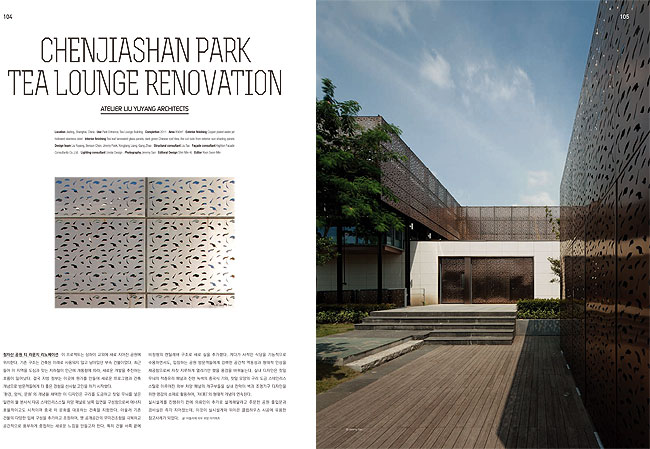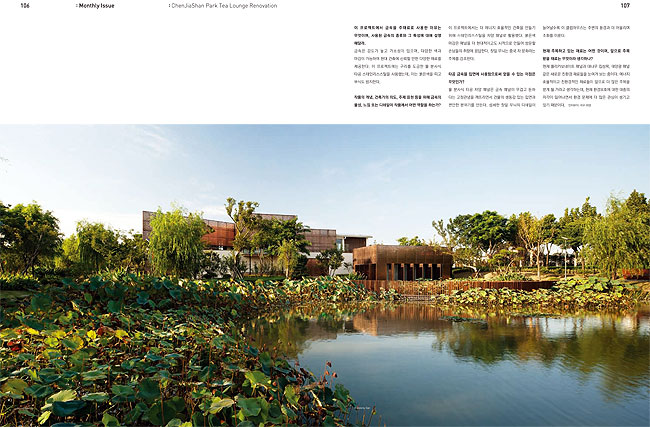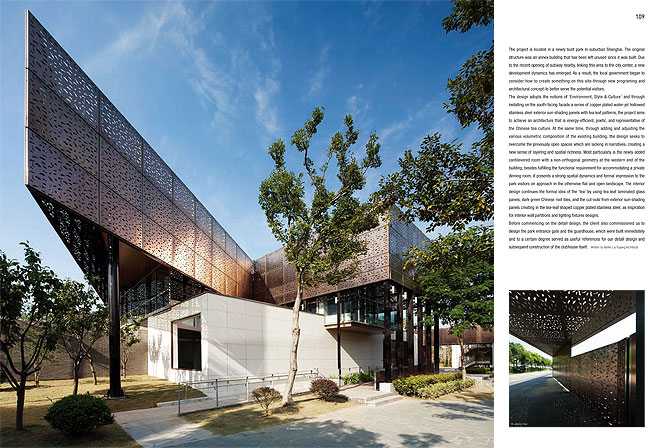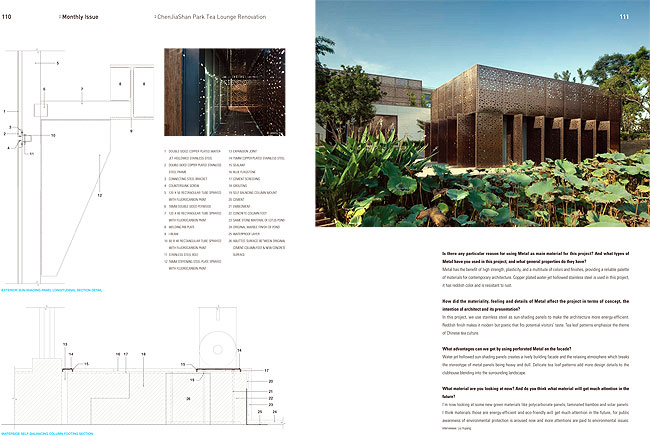ChenJiaShan Park Tea Lounge Renovation
Architect: Atelier Liu Yuyang Architects




청자산 공원 티 라운지 리노베이션 이 프로젝트는 상하이 교외에 새로 지어진 공원에 위치한다. 기존 구조는 건축된 이래로 사용되지 않고 남아있던 부속 건물이었다. 최근 들어 이 지역을 도심과 잇는 지하철이 인근에 개통함에 따라, 새로운 개발을 추진하는 흐름이 일어났다. 결국 지방 정부는 이곳에 뭔가를 만들어 새로운 프로그램과 건축 개념으로 방문객들에게 더 좋은 경험을 선사할 고민을 하기 시작했다. ‘환경, 양식, 문화’의 개념을 채택한 이 디자인은 구리를 도금하고 찻잎 무늬를 넣은 일련의 물 분사식 타공 스테인리스스틸 차양 패널로 남쪽 입면을 구성함으로써 에너지 효율적이고도 시적이며 중국 차 문화를 대표하는 건축을 지향한다. 아울러 기존 건물의 다양한 입체 구성을 추가하고 조정하여, 옛 공개공간의 무미건조함을 극복하고 공간적으로 풍부하게 중첩하는 새로운 느낌을 만들고자 한다. 특히 건물 서쪽 끝에 비정형의 캔틸레버 구조로 새로 실을 추가했다. 게다가 사적인 식당을 기능적으로 수용하면서도, 입장하는 공원 방문객들에게 강력한 공간적 역동성과 형태적 인상을 제공함으로써 자칫 지루하게 열리기만 했을 풍경을 바꿔놓는다. 실내 디자인은 찻잎 무늬의 적층유리 패널과 진한 녹색의 중국식 기와, 찻잎 모양의 구리 도금 스테인리스 스틸로 이루어진 외부 차양 패널의 개구부들을 실내 칸막이 벽과 조명기구 디자인을 위한 영감의 소재로 활용하여‘, 차(茶)’의 형태적 개념이 연속된다. 실시설계를 진행하기 전에 의뢰인이 추가로 설계해달라고 주문한 공원 출입문과 경비실은 즉각 지어졌는데, 이것이 실시설계와 뒤이은 클럽하우스 시공에 유용한 참고사례가 되었다.
글: 아뜰리에 리우 위양 아키텍츠
이 프로젝트에서 금속을 주재료로 사용한 이유는 무엇이며, 사용된 금속의 종류와 그 특성에 대해 설명 해달라.
금속은 강도가 높고 가소성이 있으며, 다양한 색과 마감이 가능하여 현대 건축에 신뢰할 만한 다양한 재료를 제공한다. 이 프로젝트에는 구리를 도금한 물 분사식 타공 스테인리스스틸을 사용했는데, 이는 붉은색을 띠고 부식도 방지한다.
작품의 개념, 건축가의 의도, 주제 표현 등을 위해 금속의 물성, 느낌 또는 디테일이 작품에서 어떤 역할을 하는가?
이 프로젝트에서는 더 에너지 효율적인 건축을 만들기 위해 스테인리스스틸을 차양 패널로 활용했다. 붉은색 마감은 패널을 더 현대적이고도 시적으로 만들어 방문할 손님들의 취향에 응답한다. 찻잎 무늬는 중국 차 문화라는 주제를 강조한다.
타공 금속을 입면에 사용함으로써 얻을 수 있는 이점은 무엇인가?
물 분사식 타공 차양 패널은 금속 패널이 무겁고 둔하 다는 고정관념을 깨뜨리면서 건물의 생동감 있는 입면과 편안한 분위기를 만든다. 섬세한 찻잎 무늬의 디테일이 늘어날수록 이 클럽하우스는 주변의 풍경과 더 어울리며 조화를 이룬다.
현재 주목하고 있는 재료는 어떤 것이며, 앞으로 주목 받을 재료는 무엇이라 생각하나?
현재 폴리카보네이트 패널과 대나무 집성목, 태양광 패널 같은 새로운 친환경 재료들을 눈여겨 보는 중이다. 에너지 효율적이고 친환경적인 재료들이 앞으로 더 많은 주목을 받게 될 거라고 생각하는데, 현재 환경보호에 대한 대중의 자각이 일어나면서 환경 문제에 더 많은 관심이 생기고 있기 때문이다.
인터뷰이: 리우 위양
The project is located in a newly built park in suburban Shanghai. The original structure was an annex building that has been left unused since it was built. Due to the recent opening of subway nearby, linking this area to the city center, a new development dynamics has emerged. As a result, the local government began to consider how to create something on this site-through new programing and architectural concept-to better serve the potential visitors. The design adopts the notions of ‘Environment, Style & Culture’ and through installing on the south-facing facade a series of copper plated water-jet hollowed stainless steel exterior sun-shading panels with tea leaf patterns, the project aims to achieve an architecture that is energy-efficient, poetic, and representative of the Chinese tea culture. At the same time, through adding and adjusting the various volumetric composition of the existing building, the design seeks to overcome the previously open spaces which are lacking in narratives, creating a new sense of layering and spatial richness. Most particularly is the newly added cantilevered room with a non-orthogonal geometry at the western end of the building, besides fulfilling the functional requirement for accommodating a private dinning room, it presents a strong spatial dynamics and formal impression to the park visitors on approach in the otherwise flat and open landscape. The interior design continues the formal idea of the ‘tea’ by using tea leaf laminated glass panels, dark green Chinese roof tiles, and the cut-outs from exterior sun-shading panels creating in the tea-leaf shaped copper plated stainless steel, as inspiration for interior wall partitions and lighting fixtures designs. Before commencing on the detail design, the client also commissioned us to design the park entrance gate and the guardhouse, which were built immediately and to a certain degree served as useful references for our detail design and subsequent construction of the clubhouse itself.
Written by Atelier Liu Yuyang Architects
Is there any particular reason for using Metal as main material for this project? And what types of Metal have you used in this project, and what general properties do they have?
Metal has the benefit of high strength, plasticity, and a multitude of colors and finishes, providing a reliable palette of materials for contemporary architecture. Copper plated water-jet hollowed stainless steel is used in this project, it has reddish color and is resistant to rust.
How did the materiality, feeling and details of Metal affect the project in terms of concept, the intention of architect and its presentation?
In this project, we use stainless steel as sun-shading panels to make the architecture more energy-efficient. Reddish finish makes it modern but poetic that fits potential visitors’ taste. Tea leaf patterns emphasize the theme of Chinese tea culture.
What advantages can we get by using perforated Metal on the facade?
Water-jet hollowed sun-shading panels creates a lively building facade and the relaxing atmosphere which breaks the stereotype of metal panels being heavy and dull. Delicate tea leaf patterns add more design details to the clubhouse blending into the surrounding landscape.
What material are you looking at now? And do you think what material will get much attention in the future?
I’m now looking at some new green materials like polycarbonate panels, laminated bamboo and solar panels. I think materials those are energy-efficient and eco-friendly will get much attention in the future, for public awareness of environmental protection is aroused now and more attentions are paid to environmental issues.
Interviewee: Liu Yuyang
건축문화 2016년 5월호 [Monthly Issue]페이지 © 에이엔씨출판(주)